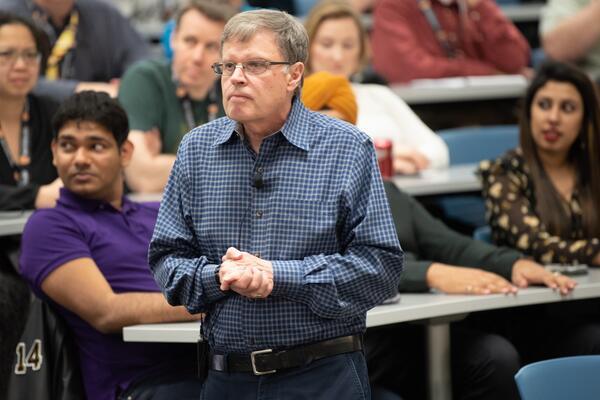
Fashion and the city
Waterloo architecture prof works with avante-garde fashion designer to create fabrics that foreshadow cities of the future.

Waterloo architecture prof works with avante-garde fashion designer to create fabrics that foreshadow cities of the future.
By Staff Communications and Public AffairsCollaboration between an architecture professor from the University of Waterloo and an avant-garde fashion designer blurs the boundaries of clothing and architecture, and could influence how cities of the future might look.

One of Iris van Herpen's designs from her Wilderness Embodied collection.
Professor Philip Beesley of the School of Architecture at Waterloo is working with Iris van Herpen, a fashion designer based in Amsterdam who has created work worn by Lady Gaga. Two exhibits are on display in France through the summer.
The unconventional collaboration sees the introduction of architectural elements to Van Herpen's clothes. As Professor Beesley put it, the two share a design language.
Living, breathing buildings
 "We were building some new hybrid fabrics and experimenting with how they might work," said Beesley. "I brought her some laser-cut, silicon 3D acrylic lace work with forests of needles and small vessels covering them. In our exchange, we explored how to construct and use new techniques to develop lightweight mesh, using modeling and digital fabrication."
"We were building some new hybrid fabrics and experimenting with how they might work," said Beesley. "I brought her some laser-cut, silicon 3D acrylic lace work with forests of needles and small vessels covering them. In our exchange, we explored how to construct and use new techniques to develop lightweight mesh, using modeling and digital fabrication."
A creation from van Herpen's Voltage Haute collection inspired by Beesley's Hylozoic series.
Exhibits in France
A series of Professor Beesley’s suspended architectural environments influenced by Van Herpen’s own explorations is continuing this exchange with Radiant Soil currently on view in the Fondation EDF Alive/En Vie exhibition, Paris, and Epiphyte Veil, currently touring throughout France.

Industrial design meets organic influences in Beesley's Radiant Soil.
Van Herpen's Fall/Winter 2013-14 collection entitled Wilderness Embodied included some of Beesley's cutting-edge contributions, as did her Voltage Haute Couture collection in January.
The pair is now working on the next generation of designs, creating new fabrics, including one that has radical, trembling extensions that resemble artificial porcupine quills.
To see more photos and projects, visit Phillip Beesley's website.

Read more
A winter holiday message from President Vivek Goel

Read more
Shop Canadian this holiday season with festive porch plants, fashion-forward apparel, craft spirits and more from Waterloo entrepreneurs

Read more
For more than four decades, Waterloo professor Larry Smith has helped build the University's reputation for innovation and entrepreneurial excellence
The University of Waterloo acknowledges that much of our work takes place on the traditional territory of the Neutral, Anishinaabeg, and Haudenosaunee peoples. Our main campus is situated on the Haldimand Tract, the land granted to the Six Nations that includes six miles on each side of the Grand River. Our active work toward reconciliation takes place across our campuses through research, learning, teaching, and community building, and is co-ordinated within the Office of Indigenous Relations.